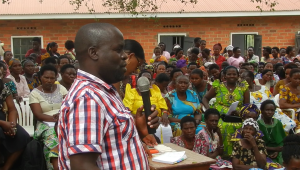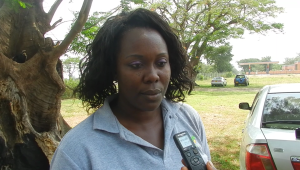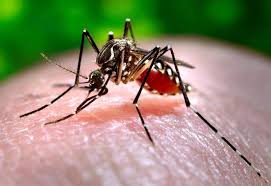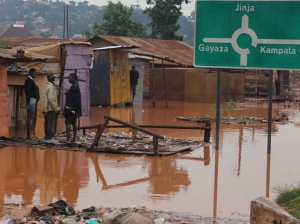Abenaitwe Cliff
Government Promotes Access to Affordable Credit in Rwenzori Region
Cliff Abenaitwe
Government through its body- The Microfinance Support Centre (MSC) has kicked off a campaign to promote access to affordable credit in the districts of Kasese, Ntoroko and Bundibugyo- in the Rwenzori Region. The campaign is targeting various categories of community members, along with District, Cultural and Religious leaders to sensitize them on the affordable funding opportunities available to increase household incomes and improve livelihoods.
Recently, a team from MSC concluded a two-week long sensitization drive of stakeholders and community members- the first of the many sensitization campaigns geared towards creating awareness and building capacity of community groups to access and benefit from government funding.

According to Hellen Petranella Matsika- an official from the MSC, over the past couple of years, government through MSC has extended cheap, affordable credit to entities in this region and more groups are being targeted for funding to alleviate poverty. “We have disbursed 29 Billion Shillings in the 9 districts of Kasese, Bunyagabu, Kasese, Bundibugyo, Ntoroko, Kamwenge, Kyenjojo, Mubende and Kabarole under our Kabarole Zonal Office, but these funds have been to SACCOS, Cooperatives and Companies”, Matsika explains. She however observed that very few community groups of people at different levels have benefited yet these groups have many members and are engaged in many income generating activities.

Out of the 29 Billion Shillings disbursed in the region so far, Kasese District has taken a lion’s share with 27 Billion Shillings going to Corporate bodies, Microfinance Institutions and Cooperatives while Bundibugyo has benefited the least with 160 Million Shillings.
One of the biggest bottlenecks according to MSC is people’s little awareness about the existence of such affordable financing. “Government has this funding opportunity and we offer different credit products at an interest between 9 and 17 percent per annum. This is the cheapest credit in Uganda but people are not aware of this. Government is now committed to improve awareness to spur development”, Matsika confidently told this site.
To drive this, officials from MSC are now training and engaging leaders, stakeholders and people from different groups in the districts of Kasese, Ntoroko and Bundibugyo to popularize this Government program in the region.
According to Belinda Atim, the MSC Public Relations Officer (PRO), bringing Political leaders, district technical leaders,

religious leaders, opinion leaders and cultural leaders on board is key in the sensitization initiatives because these people interact with Ugandans at all levels on a daily basis adding that with them, every person will get information about this affordable funding option from Government.
Key Observations So Far
According to Matsika, apart from little knowledge on the availability of these funds, people in the region though they have groups, a number of these groups are not fully registered with the office of the District Commercial Officer (DCO), many are poor at book keeping but all these can be corrected for these groups to qualify for government funding. On the other hand, Matsika observed that there are many well organized groups like the over 1000 Women Groups under the Rwenzori Catholic Diocese that are ready for funding adding that these will be funded soon to boost their income activities.
Community Responses
Mumbere Bonny Hastings- a Person Living With Disability in Bundibugyo District
People Living With Disability and other vulnerable groups like women, the elderly have for long been neglected. However, with this government funding that takes care of all groups of people, we shall be able to access affordable low-interest funds to boost our economic activities. All we need is more sensitization on how we can organize and strengthen our groups to benefit from these funds.
Mbetegyerize Godfrey- RDC Bundibugyo;

Government has come up with different programs to fight poverty. It has done its job. Now it is time for Ugandans to take advantage of these initiatives to access funds to boost economic activities. However, people who get these funds must know that it is not free money so it should be used for the right purpose to generate income so that groups are able to repay.
Mubulya Wilson- Prime Minister Obudhingiya Bwa Bwamba
The number of people accessing such good programs are still low yet people are still struggling with poverty. With more sensitization as initiated this time, awareness will improve and people will embrace this program and more others. We as cultural leaders appreciate the fact that we have a role to play in mobilising our communities to work towards prosperity.
Vila Nyeisi Muhindo- Chairperson Kasese Parish Women group

Through our different church groups, we have been saving little funds which we have been using in income generating activities like making liquid soap, buying tents and chairs for hire among other ventures. However, our scope of activities has over the years been limited by funds. We believe that with such affordable funding from government through the Microfinance Support Centre, we shall be able to expand our activities and earn more income to support of families and fight poverty.
My Opinion
Affordable financing still remains a very big issue in Uganda. Loans from Commercial Banks are charged a relatively high interest rate which makes them unattainable. What remains puzzling is that many government initiated credit and financing options are affordable but the uptake of these facilities leaves a lot to be desired.
Now that MSC has set the ball in motion, sensitization of Ugandans in different areas on how to access this affordable finance must be scaled up. To achieve this, a sustainable, multi-stakeholder approach must be adopted for effective and efficient mobilization. A cross section of Ugandans think that government financing is like a donation hence no need to bother re-paying. However, with regular monitoring of beneficiaries, the advanced funds can be put to good use and the beneficiaries will be in position to repay.
About MSC
The Microfinance Support Centre, a Government company incorporated in 2001, has since its inception disbursed close to 270b countrywide. The company boasts of a database of 5000 client institutions which have benefited from Government’s vision of prosperity for all. While the initial efforts were geared towards support to Savings and Credit Co-operative Organizations (SACCOs), services were later extended to Village Loans and Savings Associations (VSLAs), which attract more of the rural folk. Piloted in the East and Northern regions of the country, support to groups is now open countrywide with a call for informal business groups to get organized and registered at the district level so as to benefit from the provision.
MSC offers the cheapest micro-credit facility ranging from 9-17 percent and places emphasis on lending to the agricultural sector, the backbone of the economy.
Celebrities Rallied on Tobacco Control
Cliff Abenaitwe
Seeing people smoking in a music video or a movie is a common scene not only in Uganda but globally.  These scenes make smoking look fancy and this has far reaching consequences on the people especially the youth who look at musicians and movie stars as role models.
These scenes make smoking look fancy and this has far reaching consequences on the people especially the youth who look at musicians and movie stars as role models.
Health activists involved in tobacco control are concerned by this trend and want an end to it.
Andrew Kwizera, the Technical Resource Person in charge of the East African region for the Campaign for Tobacco Free Kids- a global Organisation on Tobacco Control says that many celebrities show scenes of smoking in music videos and films yet many are seen as role models to the youth. “Many young people who follow these stars have adopted smoking. This is setting a bad image to these innocent young people”, Kwizera observes adding that as a result of smoking, young people have been exposed to various tobacco related diseases which are hard and expensive to treat.

Statistics from the World Health Organization reveal that the average age of debutant smokers is 12-14 years globally.
According to Richard Baguma Tinkasimire, the coordinator Uganda Health Communication Alliance- one of the organizations at the forefront of tobacco control campaign in Uganda, young people are easily lured into smoking mainly by peer pressure and copying those they look at as role models. “Parents, leaders and celebrities must set a good example to the young generation and make children pick the best practices from them. Acts like smoking or tobacco consumption in any form should be discouraged”, he explains.
As part of the efforts to promote a smoking free generation, health activists in Uganda have adopted the use of musicians and other celebrities in the tobacco control campaigns.
Sophie Gombya- a household name in Uganda’s music industry is one of the Tobacco control ambassadors. “It’s true we have a big following, we have power to influence behavior directly or indirectly. As musicians and celebrities must be aware that what we do and show impacts on our followers.

We must therefore be mindful not to encourage bad habits like smoking among the people especially the youth who follow and adore us”, the vibrant Gombya explains.
Apart from Gombya, the Tobacco control fraternity has also used people like the Uganda National Netball Team- the ‘She Cranes’ to rally people against Tobacco- a move that Baguma says is paying off.
The Legal Framework
Uganda is a signatory of to the Framework Convention on Tobacco Control. Article 13 (4a) prohibits all forms of tobacco advertising, promotion and sponsorship that promote tobacco product by any means that are false, misleading, or deceptive or likely to create an erroneous impression about its characteristics, health effects, hazards or emissions.
Uganda’s Tobacco Control Act of 2015 also bans promotion and advertising of tobacco products, open display of tobacco products and selling of tobacco products to minors among others.
Whether showing of smoking scenes in movies and music videos is deliberate to lure people into this act, it is a clear breach of the law and the reality is- it ought to stop.
According to Kokulinda Lutgard, the head of Tanzania Tobacco Control Alliance, musicians and other celebrities have a huge impact on their following and can play a great role in Tobacco control but also everyone has a character to play in this campaign.
The Global Tobacco Burden
According to health experts, Tobacco use is one of the main risk factors for a number of chronic diseases, including cancer, lung diseases, and cardiovascular diseases.
The World Health Organisation (WHO) statistics show that Tobacco kills more than 7 million people each year worldwide with more than 6 million of those deaths as a result of direct tobacco use while around 890 000 are the result of non-smokers being exposed to second-hand smoke.
The most worrying fact is that nearly 80 percent of the world’s more than 1 billion smokers live in low- and middle-income countries where the burden of tobacco-related illness and death is heaviest and alarming.
Over the years, significant strides have been made in Tobacco Control but this is more in developed countries than in the developing world.

A 2017 report by WHO on “Monitoring tobacco use and prevention policies” reveal that more countries have implemented tobacco control policies, ranging from graphic pack warnings and advertising bans to no smoking areas. About 4.7 billion people – 63 percent of the world’s population are covered by at least one comprehensive tobacco control measure, which has quadrupled since 2007 when only 1 billion people and 15 percent of the world’s population were covered.
Uganda has an estimated 1.3 Million smokers- according to the Global Adult Tobacco Survey (GATS) report of 2013 with each smoker spending an average of 20, 730 Shillings (about 6 USD) on manufactured cigarettes per month.
Kidney Transplant Survival Up Among Babies
Survival rates for children who get kidney transplants have improved significantly over the last half-century, a new study finds.
“The outlook for infants and children with end-stage kidney disease was once dismal, with poor survival rates after transplant. There has been great progress in pediatric kidney transplantation, and now the patient survival rate is almost 100 percent,” said the study’s principal investigator, Dr. Srinath Chinnakotla.
Chinnakotla is an associate professor of surgery at the University of Minnesota Masonic Children’s Hospital in Minneapolis, where the study was done.
Since 2002, 97 percent of children who had kidney transplants at the hospital were alive a year later. That compares to 85 percent 40 to 50 years ago, the study showed. Read More..
Comment:
This is absolutely good news and light at the end of the tunnel. With this break-through, more children will survive kidney transplant and this is a strong foundation for further improvements in the entire health system. However, as we celebrate this good news, it is equally important to think about thousands if not millions of disadvantaged children who desperately need a kidney transplant but cannot be saved either because of the poor economic nature of their families or lack of such services in major health facilities nearby.
Source: MedlinePlus
Comment by: Cliff Abenaitwe
Cutting Salt a Health Boost for Kidney Patients
Blood pressure and fluid retention improve in those counseled by dietitians, small study shows
Encouraging people with kidney disease to reduce their salt intake may help improve blood pressure and cut excess fluid retention, at least for a while, a new study suggests.
Study participants lowered their systolic blood pressure (the top number)

by almost 11 points, on average, on a salt-restricted diet versus their usual diet. They also flushed out a liter of water (about one-quart) from their bodies, on average, by slashing salt in their diets, researchers said.
Having high blood pressure and retaining excess salt and water in the body stresses the heart and blood vessels, explained lead author Dr. Rajiv Saran of the University of Michigan.
For kidney disease patients, high blood pressure (or “hypertension”) and excess fluid in the body can be a toxic combination. “They die predominantly of cardiovascular disease,” said Saran, a professor of internal medicine and epidemiology in the nephrology division.
Yet doctors rarely have time or make time to counsel each patient about salt-restricted diets, he said.
Saran and co-investigators wondered whether having trained dietitians talk to patients with chronic kidney disease by phone or in person about ways to lower daily sodium intake would make a difference. Read More
SOURCE: medlineplus.gov
New clinical guideline issued for treating low back pain
Low back pain affects millions of people in the United States, and the condition is one of the most common reasons for people missing work.  New guidelines from the American College of Physicians recommend noninvasive ways of treating nonradicular low back pain.
New guidelines from the American College of Physicians recommend noninvasive ways of treating nonradicular low back pain.
The American Chiropractic Association (ACA)

report that approximately 31 million U.S. individuals experience low back pain at one point during their lives. The ACA also note that low back pain is the leading cause of disability across the world, as well as one of the most popular reasons why people miss work.
The condition accounts for a large proportion of all doctor visits in the U.S., and almost 25 percent of the entire adult population in the U.S. has experienced at least one day of low back pain in the past 3 months.
Quote: medicalnewstoday.com
ROTARY BOOST GLOBAL FIGHT AGAINST POLIO
The fight against Polio has been boosted by a new grant from Rotary International- the largest group of committed volunteering men and women committed to serve and change the world.

Rotary has announced $35 million in grants to support the global effort to end polio, bringing the humanitarian service organization’s contribution to $140 million since January 2016.
Nearly half of the funds Rotary announced January 2017 ($16.15 million) will support the emergency response campaigns in Nigeria and the Lake Chad Basin (Chad, northern Cameroon, southern Niger and Central African Republic). Four cases of polio were detected in Nigeria in 2016, which had previously not seen a case since July 2014.
With these cases, funding is needed to support rapid response plans in Nigeria and surrounding countries to stop the outbreak.
While significant strides have been made against the paralyzing disease, with just 35 cases reported in 2016, polio remains a threat in hard-to-reach and underserved areas, and conflict zones. To sustain this progress, and protect all children from polio, experts say $1.5 billion is needed.
In addition to supporting the response in the Lake Chad Basin region, funding has been allocated to support polio eradication efforts in Afghanistan ($7.15 million), Pakistan ($4.2 million), Somalia ($4.64 million), and South Sudan ($2.19 million). A final grant in the amount of $666,845 will support technical assistance in UNICEF’s West and Central Africa Regional Office.
Rotary has contributed more than $1.6 billion, including matching funds from the Bill and Melinda Gates Foundation, and countless volunteer hours since launching its polio immunization program, PolioPlus, in 1985. In 1988, Rotary became a spearheading partner in the Global Polio Eradication Initiative with the World Health Organization (WHO), UNICEF, U.S. Centers for Disease Control and Prevention, and was later joined by the Bill & Melinda Gates Foundation. Since the initiative launched, the incidence of polio has plummeted by more than 99.9 percent, from about 350,000 cases a year to 35 confirmed in 2016, and no cases in 2017 so far.
What is Polio?
According to the World Health Organization (WHO), Poliomyelitis (polio) is a highly infectious viral disease, which mainly affects young children.
The virus is transmitted by person-to-person spread mainly through the faecal-oral route or, less frequently, by a common vehicle (e.g. contaminated water or food) and multiplies in the intestine, from where it can invade the nervous system and can cause paralysis.
Initial symptoms of polio include fever, fatigue, headache, vomiting, stiffness in the neck, and pain in the limbs. In a small proportion of cases, the disease causes paralysis, which is often permanent. There is no cure for polio, it can only be prevented by immunization.
Key Facts about Polio
- Polio (poliomyelitis) mainly affects children under 5 years of age.
- 1 in 200 infections leads to irreversible paralysis. Among those paralysed, 5% to 10% die when their breathing muscles become immobilized.

In a small proportion of cases, the disease causes paralysis, which is often permanent.
- Polio cases have decreased by over 99% since 1988, from an estimated 350 000 cases then, to 74 reported cases in 2015. The reduction is the result of the global effort to eradicate the disease.
- As long as a single child remains infected, children in all countries are at risk of contracting polio. Failure to eradicate polio from these last remaining strongholds could result in as many as 200,000 new cases every year, within 10 years, all over the world.
- In most countries, the global effort has expanded capacities to tackle other infectious diseases by building effective surveillance and immunization systems
About Rotary
Rotary brings together a global network of volunteer leaders dedicated to tackling the world’s most pressing humanitarian challenges. Rotary connects over 1.2 million members of more than 35,000 Rotary clubs in over 200 countries and geographical areas.
Zika outbreak: The mosquito menace
The mosquito, Aedes aegypti,  is causing widespread fear in Brazil where it is spreading the Zika virus that has been linked to thousands of babies being born with birth defects.
is causing widespread fear in Brazil where it is spreading the Zika virus that has been linked to thousands of babies being born with birth defects.
So what do we know about it?
It loves our cities
This is not some jungle-dwelling insect that rarely comes into contact with people.
It is one of those animals, like cockroaches, pigeons and urban foxes, that thrives in built-up areas.
It does not need natural water sources to breed as it can lay eggs in the small and plentiful pools of stagnant water, such as gutters or flower pots, found in cities . Read more
Why Sleeping in Could Make You a Better Worker
If you find yourself hitting the snooze button every morning, don’t blame yourself. Your work schedule could be to blame.
A growing field of research now shows that, for many of us, our work schedules are wildly out of sync with our natural body clocks — and experts are urging employers to take notice.
Sleep is a “strategic resource” that most companies are ignoring, according to a white paper by Christopher Barnes, a management professor at the University of Washington’s Foster School of Business in the US (Read more)
Source: bbc.com




